
This article will explain how to conduct a nursing head-to-toe health assessment. This assessment is similar to what you will be required to perform in nursing school.
As you gain experience, you will conduct the assessment in a way that works for you and will become faster overtime. Also depending on what specialty you are working in, you will tweak what areas you will focus on during the assessment.
The sequence for performing a head-to-toe assessment is:
However, with the abdomen it is changed where auscultation is performed second instead of last. The order for the abdomen would be:
Provide privacy, perform hand hygiene, introduce yourself to the patient, and explain to the patient that you need to conduct a head-to-toe assessment
Ask the patient to confirm their name and date of birth by looking at the patient’s wrist band (this helps assess orientation to person and confirms you have the right patient). In addition, ask the patient where they are, the current date, and current events (who is the president and vice president) etc.
Collect vital signs: heart rate, blood pressure, temperature, oxygen saturation, respiratory rate, pain level
NOTE: Before even assessing a body system, you are already collecting important information about the patient. For example, you should already be collecting the following information :
Assess height and weight and calculate the patient’s BMI (body mass index).
Below 18.5 = Underweight
18.5-24.9 = Normal weight
30.0 or Higher = Obese
Then start with the hair and move down to the toes:
Inspect the face and hair:

Palpate the cranium and inspect the hair for infestations, hair loss, skin breakdown or abnormalities:
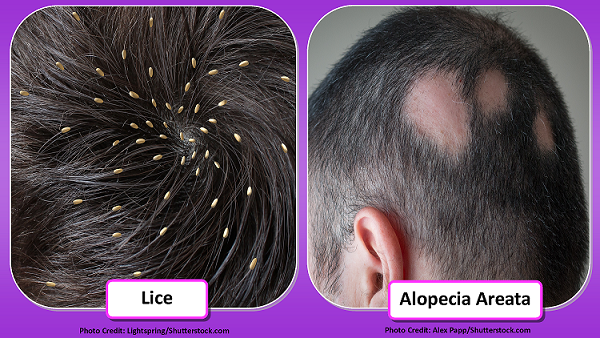
Palpate the temporal artery bilaterally
Test Cranial Nerve V…..trigeminal nerve: This nerve is responsible for many functions and mastication is one of them.
Palpate the temporomandibular joint for grating or clicking: Have the patient open and close the mouth and feel for any grating sensation or clicking.
Palpate the frontal and maxillary sinuses for tenderness: patient will pressure but should not feel pain
Inspect the eyes, eye lids, pupils, sclera, and conjunctiva

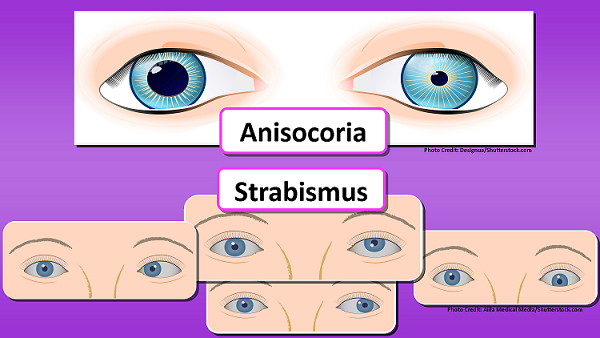
Test cranial nerves III (oculomotor), IV (trochlear), VI (abducens)
If all these findings are normal you can document PERRLA.
Inspect the ears for:

Tests cranial nerve 8 VIII…vestibulocochlear nerve:
Inspect the tympanic membrane:
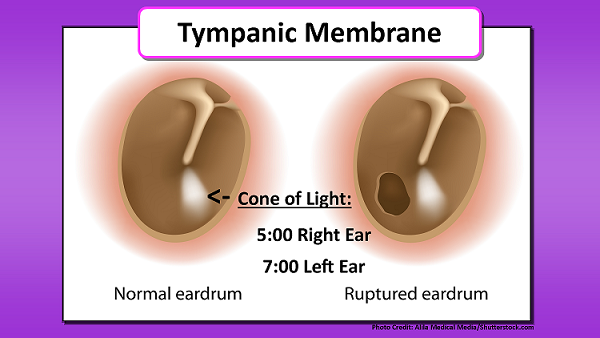
Inspect nose
Test cranial nerve I..….olfactory nerve: Have the patient close their eyes and place something with a pleasant smell under the nose and have them identify it.
Inspect lips (lip should be pink NOT dusky or blue/cyanotic or cracked, and free from lesions)
Inspect the inside of the mouth:
Inspect tongue:
Inspect hard and soft palate and tonsils (no exudate on tonsils) and uvula should be midline
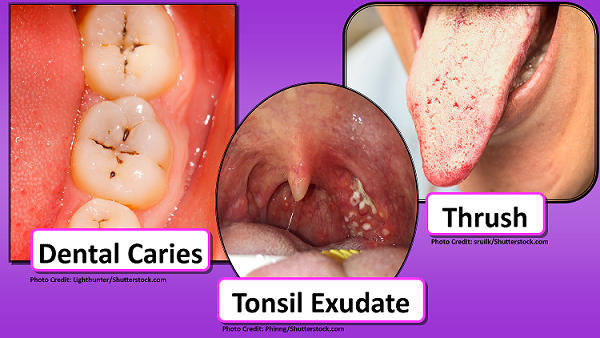
Test cranial nerve XII….hypoglossal: have patient stick tongue out and move it side to side
Test cranial nerve IX (glossopharyngeal) and X (vagus) have patient say “ah”…the uvula will move up (cranial nerve IX intact) and if the patient can swallow with ease and has no hoarseness when talking, cranial nerve X is intact.
Inspect the trachea

Test cranial nerve XI….accessory nerve: Have the patient move head from side to side and up and down and shrug shoulders against resistance.
Inspect for jugular vein distention
Palpate the lymph nodes with the pads of fingers and feel for lumps, hard nodules, or tenderness:
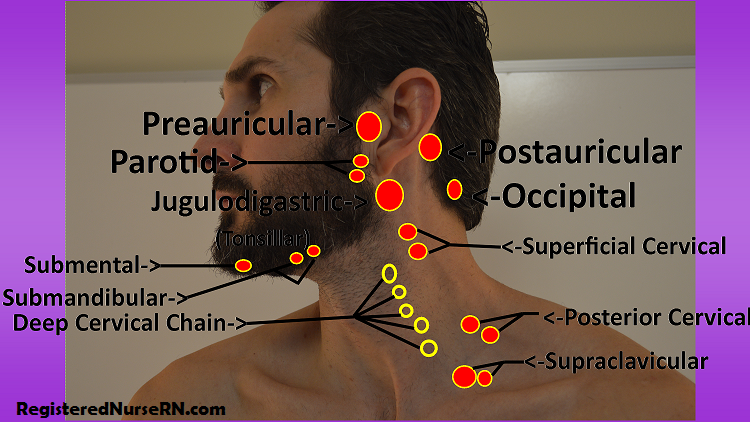
Palpate the trachea and confirm it is midline
Palpate thyroid gland from the back: note for nodules, tenderness or enlargement…normally can’t palpate it.
Palpate the carotid artery (one side at a time) and grade it (0 to 4+….2+ is normal)
Auscultate for bruits at the carotid artery with BELL of stethoscope (listen for a swooshing sound which is a bruit)…have patient breathe in and out and hold it while listening.
Inspect arms and hands

Palpate joints (elbows, wrist, and hands) for redness and move the joints (note any decreased range of motion or crepitus)
Palpate skin temperature
Palpate radial artery BILATERALLY and grade it. If the patient receives dialysis and has an AV fistula, confirm it has a thrill present.
Have the patient extend their arms and move the arms against resistance and flex against resistance (grade strengthen 0-5) along with having the patient squeeze your fingers (note the grip).
Assess for arm drift by having the patient close their eyes and extend both arms for ten seconds. Note any drifting.
Inspect the chest
Heart Sounds:
Auscultate heart sounds at 5 locations, specifically valve locations:
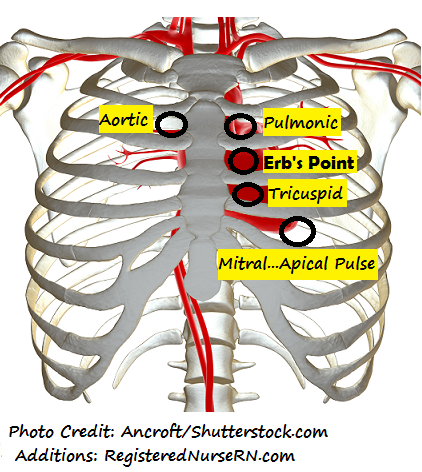
Aortic: found right of the sternal border in the 2nd intercostal space REPRESENTS S2 “dub” which is the loudest.
Pulmonic: found left of the sternal border in the 2nd intercostal space REPRESENTS S2 “dub” which is the loudest.
Erb’s Point: found left of the sternal border in the 3rd intercostal space…no valve here just the halfway point.
Tricuspid: found left of the sternal border in the 4th intercostal space REPRESENTS S1 “lub”.
Mitral: found midclavicular in the 5th intercostal space REPRESENTS S1 “lub” (also the site of point of maximal impulse) APICAL PULSE….count pulse for 1 full minute.
Then listen with the BELL of the stethoscope at the same locations: for a blowing or swooshing noise…heart murmur.
Lung Sounds:
If you would like to hear some abnormal lung sounds, please watch our video called “abnormal lung sounds”.
Auscultate anteriorly:

Auscultate posteriorly:
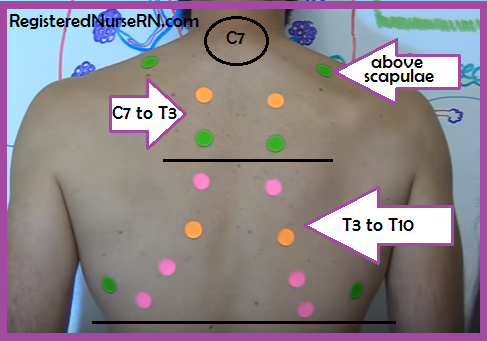
Switching to Inspection, Auscultation, Percussion, and Palpation
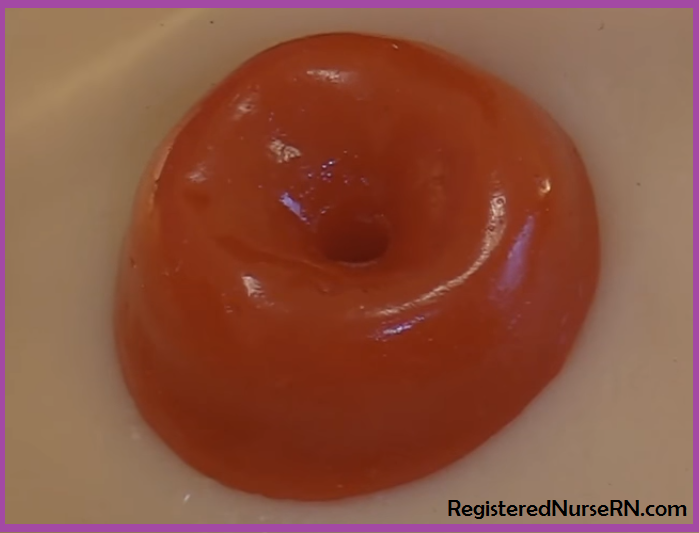
Inspect:
Auscultate with the diaphragm for bowel sounds:
Auscultate for bruits (vascular sounds) at the following locations using the BELL of the stethoscope:
Check for hernia: have patient raise up a bit and look for hernia (at stomach area or navel area)
Palpation of the abdomen:
Inspect:
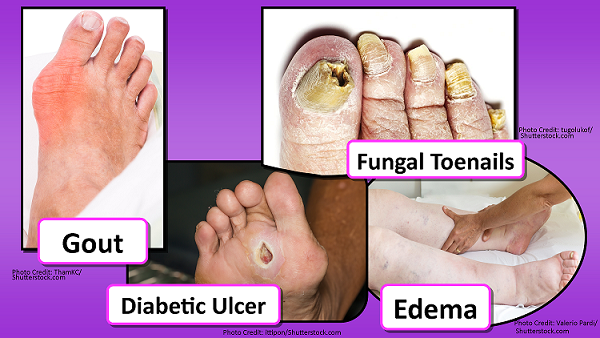
Palpate pulses bilaterally: popliteal (behind the knee), dorsalis pedis (top of foot), posterior tibial (at the ankle) and grade them
Palpate muscle strength: have patient push against resistance with feet and lift legs
Test Babinski reflex: curling toes is a negative normal response
Turn patient over and look at back (could listen to lung sounds if haven’t already) look for skin breakdown on back and bottom and abnormal moles